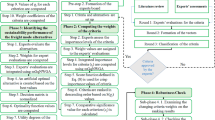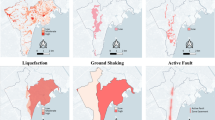Abstract
Humanitarian relief logistics is one of the most important elements of a relief operation in disaster management. The present work develops a multi-objective robust stochastic programming approach for disaster relief logistics under uncertainty. In our approach, not only demands but also supplies and the cost of procurement and transportation are considered as the uncertain parameters. Furthermore, the model considers uncertainty for the locations where those demands might arise and the possibility that some of the pre-positioned supplies in the relief distribution center or supplier might be partially destroyed by the disaster. Our multi-objective model attempts to minimize the sum of the expected value and the variance of the total cost of the relief chain while penalizing the solution’s infeasibility due to parameter uncertainty; at the same time the model aims to maximize the affected areas’ satisfaction levels through minimizing the sum of the maximum shortages in the affected areas. Considering the global evaluation of two objectives, a compromise programming model is formulated and solved to obtain a non-dominating compromise solution. We present a case study of our robust stochastic optimization approach for disaster planning for earthquake scenarios in a region of Iran. Our findings show that the proposed model can help in making decisions on both facility location and resource allocation in cases of disaster relief efforts.
Similar content being viewed by others
References
Akkihal A (2006) Inventory pre-positioning for humanitarian operations. Thesis for Degree of Master of Engineering in Logistics, MIT CTL
Altay N, Green WG (2006) OR/MS research in disaster operations management. Eur J Oper Res 175(1): 475–493
Amiri A (2006) Designing a distribution network in a supply chain: formulation and efficient solution procedure. Eur J Oper Res 171: 567–576
Azaron A, Brown KN, Tarim SA, Modarres M (2008) A multiobjective stochastic programming approach for supply chain design considering risk. Int J Prod Econ 116: 129–138
Bakuli DL, Smith JM (1996) Resource allocation in state-dependent emergency evacuation networks. Eur J Oper Res 89(4): 543–555
Balcik B, Beamon BM (2008) Facility location in humanitarian relief. Int J Logist Res Appl 11(2): 101–121
Barbarosoglu G, Ozdamar L, Cevik A (2002) An interactive approach for hierarchical analysis of helicopter logistics in disaster relief operations. Eur J Oper Res 140: 118–133
Barbarosoglu G, Arda Y (2004) A two-stage stochastic programming framework for transportation planning in disaster response. J Oper Res Soc 55: 43–53
Beamon BM, Kotleba SA (2006) Inventory modeling for complex emergencies in humanitarian relief operations. Int J Logist Res Appl 9(1): 1–18
Beraldi P, Bruni ME, Conforti D (2004) Designing robust emergency medical service via stochastic programming. Eur J Oper Res 158(1): 183–193
Beraldi P, Bruni ME (2009) A probabilistic model applied to emergency service vehicle location. Eur J Oper Res 196(1): 323–331
Berberian M, Yeats RS (2001) Contribution of archaeological data to studies of earthquake history in the Iranian plateau. J Struct Geol 23: 563–584
Blecken A, Hellingrath B, Dangelmaier W, Schulz SF (2009) A humanitarian supply chain process reference model. Int J Serv Technol Manag 12(4): 391–413
Brotcorne L, Laporte G, Semet F (2003) Ambulance location and relocation models. Eur J Oper Res 147(3): 451–463
Campbell AM, Vandenbussche D, Hermann W (2008) Routing for relief efforts. Transp Sci 42(2): 127–145
Chang MS, Tseng YL, Chen JW (2007) A scenario planning approach for the flood emergency logistics preparation problem under uncertainty. Transp Res Part E 43(6): 737–754
Cormican KJ, David P, Morton R, Kevin W (1998) Stochastic network interdiction. Oper Res 46(2): 184–197
Davis T (1993) Effective supply chain management. Sloan Manag Rev 34(4): 35–46
Doerner KF, Hartl RF (2008) Health care logistics, emergency preparedness, and disaster relief: new challenges for routing problems with a focus on the Austrian situation. In: The vehicle routing problem: latest advances and new challenges, Part III. Springer, USA, pp 527–550
Fiedrich A, Gehbauer F, Rickers U (2000) Optimized resource allocation for emergency response after earthquake disasters. Saf Sci 35: 41–57
Haghani A, Afshar AM (2009) Supply chain management in disaster response. Final Project report, Department of Civil & Environmental Engineering, University of Maryland
Haghani A, Oh SC (1996) Formulation and solution of a multi-commodity, multi-modal network flow model for disaster relief operations. Transp Res part A Pol 30(3): 231–250
Han LD, Yuan F, Chin SM, Hwang H (2006) Global optimization of emergency evacuation assignments. Interfaces 36(6): 502–513
Jafari MA (2010) Statistical prediction of the next great earthquake around Tehran, Iran. J Geodyn 49: 14–18
Jia H, Ordonez F, Dessouky M (2007a) A modeling framework for facility location of medical services for large-scale emergencies. IIE Trans 39(1): 41–55
Jia H, Ordonez F, Dessouky M (2007b) Solution approaches for facility location of medical supplies for large-scale emergencies. Comput Ind Eng 52(2): 257–276
Knott R (1987) The logistics of bulk relief suppliers. Disaster 11: 113–115
Knott R (1988) Vehicle routing for emergency relief management: a knowledge-based approach. Disaster 12: 285–293
Kovacs G, Spens KM (2007) Humanitarian logistics in disaster relief operations. Int J Phys Distrib Logist Manag 37(2): 99–114
Lodree EJ, Taskin S (2008) An insurance risk management framework for disaster relief and supply chain disruption inventory planning. J Oper Res Soc 59(5): 674–684
Mert A, Adivar BO (2010) Fuzzy disaster relief planning with credibility measures. In: 24th Mini EURO conference on Continuous optimization and information-based technologies in the financial sector, June 23–26, Izmir, Turkey
Mete ON, Zabinsky Z (2010) Stochastic optimization of medical supply distribution. Int J Prod Econ 126: 76–84
Mirzapour Al-e-hashem SMJ, Malekly H, Aryanezhad MB (2011) A multi-objective robust optimization model formulation product multi-site aggregate production planning in a supply chain under uncertainty. Int J Prod Econ. http://dx.doi.org/10.1016/j.ijpe.2011.01.027
Mulvey JM, Vanderbei RJ, Zenios SA (1995) Robust optimization of large-scale systems. Oper Res 43(2): 264–281
Nateghi AF (2001) Earthquake scenario for the mega-city of Tehran. Disaster Prev Manag 10(2): 95–100
Nazari H, Ritz JF, Salamati R, Solaymoni S, Balescu S, Michelot, JL, Ghassemi A, Talebian M, Lamothe M, Massaulut M (2007) Paleoseismological analysis in Central Alborz. In: 50th Anniversary earthquake Conference commemorating the 1957 Gobi-Altay earthquake (July–August 2007, Ulaanbaatar-Mongolia)
Nowroozi AA (2010) Probability of peak ground horizontal and peak ground vertical accelerations at Tehran and surrounding areas. Pure Appl Geophys 167: 1459–1474
Ozbay K, Ozguven EE (2007) Stochastic humanitarian inventory control model for disaster planning. Transp Res Rec 2022(1): 63–75
Ozdamar L, Ekinci E, Kucukyazici B (2004) Emergency logistics planning in natural disasters. Ann Oper Res 129(1–4): 217–245
Parentela E, Nambisan SS (2000) Emergency response (disaster management). In: Urban planning and development applications of GIS, ASCE, Reston, VA, pp 181–196
Rawls CG, Turnsquist MA (2010) Pre-positioning of emergency supplies for disaster response. Transp Res Part B Methodol 44(4): 521–534
Regnier E (2008) Public evacuation decisions and hurricane track uncertainty. Manag Sci 54(1): 16–28
Romero C, Tamiz M, Jones DF (1998) Goal programming, compromise programming and reference point method formulations: linkages and utility interpretations. J Oper Res Soc 49(9): 986–991
Saadatseresht M, Mansourian A, Taleai M (2009) Evacuation planning using multi-objective evolutionary optimization approach. Eur J Oper Res 198: 305–314
Sakakibara H, Kajitani Y, Okada N (2004) Road network robustness for avoiding functional isolation in disasters. J Transp Eng ASCE 130: 560–567
Salmeron J, Apte A (2010) Stochastic optimization for natural disaster asset prepositioning. Prod Oper Manag 19(5): 561–574
Sheu JB (2007) An emergency logistics distribution approach for quick response to urgent relief demand in disasters. Transp Res Part E 43(6): 687–709
Sheu JB (2010) Dynamic relief-demand management for emergency logistics operations under large-scale disasters. Transp Res Part E 46: 1–17
Stepanov A, Smith JM (2009) Multi-objective evacuation routing in transportation networks. Eur J Oper Res 198: 435–446
Tomasini RM, Van Wassenhove LN (2004) Pan-American health organization’s humanitarian supply management system: de-politicization of the humanitarian supply chain by creating accountability. J Public Procur 4(3): 437–449
Toregas C, Swain R, ReVelle C, Bergman L (1971) The location of emergency service facilities. Oper Res 19(6): 1363–1373
Tzeng GH, Cheng HJ, Huang TD (2007) Multi-objective optimal planning for designing relief delivery systems. Transp Res Part E 43(6): 673–686
Ukkusuri S, Yushimito W (2008) Location routing approach for the humanitarian prepositioning problem. Transp Res Rec 2089: 18–25
Van Wassenhove LN (2006) Humanitarian aid logistics: supply chain management in high gear. J Oper Res Soc 57(5): 475–489
Van Wassenhove LN, Martinez AJP, Stapleton O (2010) An Analysis of the relief supply chain in the first week after the Haiti earthquake. INSEAD Humanitarian Research Group. http://www.insead.edu/facultyresearch/centres/isic/documents/HaitiReliefSupplyChain_Final25Jan_.pdf
Viswanath K, Peeta S (2003) Multi-commodity maximal covering network design problem for planning critical routes for earthquake response. Transp Res Rec 1857: 1–10
Whybark DC (2007) Issues in managing disaster relief inventories. Int J Prod Econ 108(1–2): 228–235
Yi W, Kumar A (2007) Ant colony optimization for disaster relief operations. Transp Res Part E 43: 660–672
Yi W, Ozdamar L (2007) A dynamic logistics coordination model for evacuation and support in disaster response activities. Eur J Oper Res 179: 1177–1193
Yu CS, Li HL (2000) A robust optimization model for stochastic logistic problems. Int J Prod Econ 64(1–3): 385–397
Author information
Authors and Affiliations
Corresponding author
Rights and permissions
About this article
Cite this article
Bozorgi-Amiri, A., Jabalameli, M.S. & Mirzapour Al-e-Hashem, S.M.J. A multi-objective robust stochastic programming model for disaster relief logistics under uncertainty. OR Spectrum 35, 905–933 (2013). https://doi.org/10.1007/s00291-011-0268-x
Published:
Issue Date:
DOI: https://doi.org/10.1007/s00291-011-0268-x




